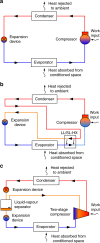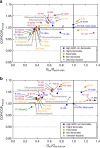Limited options for low-global-warming-potential refrigerants
- PMID: 28211518
- PMCID: PMC5321723
- DOI: 10.1038/ncomms14476
Limited options for low-global-warming-potential refrigerants
Abstract
Hydrofluorocarbons, currently used as refrigerants in air-conditioning systems, are potent greenhouse gases, and their contribution to climate change is projected to increase. Future use of the hydrofluorocarbons will be phased down and, thus replacement fluids must be found. Here we show that only a few pure fluids possess the combination of chemical, environmental, thermodynamic, and safety properties necessary for a refrigerant and that these fluids are at least slightly flammable. We search for replacements by applying screening criteria to a comprehensive chemical database. For the fluids passing the thermodynamic and environmental screens (critical temperature and global warming potential), we simulate performance in small air-conditioning systems, including optimization of the heat exchangers. We show that the efficiency-versus-capacity trade-off that exists in an ideal analysis disappears when a more realistic system is considered. The maximum efficiency occurs at a relatively high volumetric refrigeration capacity, but there are few fluids in this range.
Conflict of interest statement
The authors declare no competing financial interests.
Figures




References
-
- European Parliament. Regulation (EU) No. 517/2014 of the European Parliament and of the Council of 16 April 2014 on fluorinated greenhouse gases and repealing Regulation (EC) No. 842/2006. Official Journal of the European Union L150, 195–230 (2014).
-
- UNEP Ozone Secretariat. in Twenty-Eighth Meeting of the Parties to the Montreal Protocol on Substances that Deplete the Ozone Layer (Kigali, Rwanda, 2016); document UNEP/OzL.Pro.28/CRP/10, United Nations Environment Programme, 2016.
-
- ANSI/ASHRAE Standard 34-2013 Designation and Safety Classification of Refrigerants (ASHRAE, 2013).
-
- ISO Standard 817:2014 Refrigerants—Designation and Safety Classification (International Organization for Standardization, 2014).
Publication types
LinkOut - more resources
Full Text Sources
Other Literature Sources

